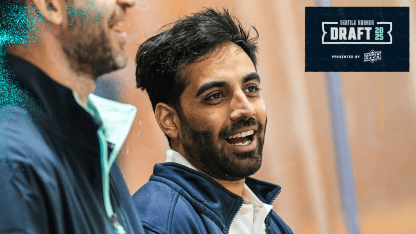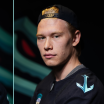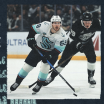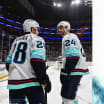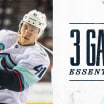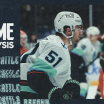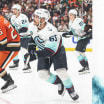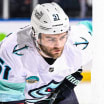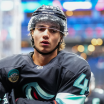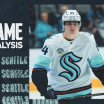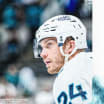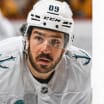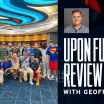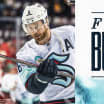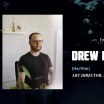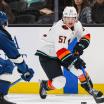Like pretty much all Canadian kids, Kraken player development consultant Justin Rai played hockey from a young age. What’s different about Rai is that he wielded a hockey stick on and off the ice all four seasons, year in and year out.
“I played other sports, but my family and I always laugh because I played every single type of hockey possible,” said Rai on a recent afternoon after summer training sessions with an impressive group of B.C.-based NHLers and Kraken prospects. “I played ice hockey, ball hockey, roller hockey, and field hockey. It’s all I ever wanted to do.”
Rai, who played college hockey at the NCAA Division I University of Maine, didn’t have to look far or even tune into hockey telecasts growing up in Surrey, BC. His father played on Canada’s field hockey team in the 1988 Summer Olympics in Seoul, South Korea.
“My dad was my inspiration,” said Rai. “I remember being three, four years old – my parents have shown me videos and photos too – I just always had a hockey stick in my hand. It was pretty cool to stick-handle out in the backyard with my dad, competing against him one-on-one. We were training for me to have success, but it was the most fun part of my day anyway.
“My dad was probably one of the most crafty stick handlers I've ever seen. I learned so much from the way he thinks about the craft of hockey. He'd had a good eye for skills, drills, and player development. He'd give me a couple of tips, and then I'd go out to the backyard to practice. I loved it.”
From Student to Teacher/Innovator
Rai’s love of the game and childhood immersion into skills drills sparked a post-playing day career into the cutting edge of player development. He is a deep thinker about what NHL players and prospects most need to learn to excel in games. He applies those results to Kraken prospects year-round, plus an impressive list of NHLers during B.C. summers, including Connor Bedard, Mat Barzal, Kent Johnson, Owen Zellwegger, Danton Heinen, Fraser Minton, plus Seattle forward Tye Kartye and defensemen prospects Lukas Dragicevic, Kaden Hammel and Tyson Jugnauth (the latter two signed entry-level contracts this summer and Dragicevic signed last summer).
Rai completed his hockey journey as a player at the University of British Columbia, earning a degree in human kinesiology. After finishing his undergrad work, Rai started “getting on the ice with a wide range of players.” In 2019, he landed a skills coach role with the Coquitlam Express of the junior British Columbia Hockey League (BCHL) and set up a startup hockey skills development company called Kaivo.
The eureka moment for Rai as a player development coach emerged while working with NHLer and BCHL Coquitlam alum Alex Kerfoot. He was applying the “heavy biomechanics on how the body moves” from his undergraduate studies to work on adjusting “how to be most efficient in your movement, where to keep your hands on the stick, shin angles and that type of stuff.” Rai credits Kerfoot and other NHLers in a small skating group several summers ago for prompting a reboot of his player development approach.
After Rai showed the players the planned drills he derived from video analysis to enhance the NHLers’ games, Kerfoot posed a question about how many video reviews were needed to find the biomechanical adjustments to be taught. The answer was 80 game videos to find 15 suitable examples. Kerfoot suggested spending summer training time on an action he used just 15 times in 80 games didn’t seem efficient. The lifelong learner in Rai agreed.
“That blew me away because it was so true,” said Rai. “For the next four to five years, I picked the top 25 guys in the world, which is subjective, but all players I like to watch and who would lead the league in points. I would clip them every single night of the season to figure out commonalities. Was it a read they made off the rush? Was it the way they moved, was it a deke they did? Was it a read they made off the rush? Was it an o-zone off-puck movement that they made?
“I started realizing most of the game is played without the puck. And most of these reads that these top-end players are doing are their reads within the coaching system, but they're finding ways to get themselves open. Are there any commonalities between them? That created my niche. COVID hit, and I had tens of thousands of video clips [or elite player reads]. What I did was sit through these and try to figure out my main discoveries. From there, I felt I had an actual resource that could help high-end talent and created a video program of all these reads and off-puck movement."
Connecting to the Kraken
That video program transitioned Rai to be “less a skills coach to more player development-focused role.” Rai began working with players like the aforementioned Kerfoot and other NHLers, as well as local B.C.-based prospects. He talked with his clients about “your reads and the high-volume plays you're making, your off-puck movement, how that's affecting your overall game.”
“Justin is one of the best young hockey minds in our business today,” said Jeff Tambellini, Kraken director of player development. “His foundational concepts for development differ from anything I’ve seen in the game. We’ve been very fortunate to have him on our staff for the past three seasons. He has a relentless work ethic. It’s the trait that I value in him the most. He pairs that work with an innovative perspective for attacking on-ice problems.”
“I had a product I could introduce to elite players [in the Vancouver area],” said Rai. “It led me to meeting Jeff, who, in juniors, coached [Columbus forward and former Matty Beniers’ NCAA Michigan teammate] Kent Johnson. We connected through Kent. As my company grew, my relationship with Jeff grew. Jeff asked to do some research to see if my program could be used in scouting or player development.”
When Tambellini left the Tampa Bay Lightning organization to become a Kraken executive, he took the opportunity to hire Rai. During the regular season, Tambellini and Rai take frequent trips to the Coachella Valley to work directly with Kraken prospects playing for the American Hockey League's Firebirds, often obtaining permission from head coach Derek Laxdal to incorporate desired drills into practices. Plus, there are always additional one-on-one sessions with prospects, who have all raved about Rai’s work on reads and off-puck movement.
“Justin has an amazing ability to connect with all of our prospects and build rapport with them,” said Tambellini. "Our players have been amazed when they see his video analysis of their game [especially reads and off-puck movement], and then how he pairs it with his on-ice component.”
Maximizing On-Ice Reads – and Peripheral Vision
“For me, it is about using the information, then processing and practicing it to see how that leads to a player’s off-puck routes and decision-making,” said Rai. “The more clips I did, the more it seemed to me those reads are way more important [than physical adjustments] at the NHL level.”
When doing reps on the ice with players to learn how to improve reads, Rai first explains the concepts and provides a relatable example: “You see players go for a puck retrieval and scan three times. Then they made a read that didn't really make sense ... in reality, the players scanned three times so fast that they just saw a bunch of blurriness. We talk about trying to gather relevant information to make an effective read. The whole point is that every time we scan, it's for a purpose.
“We discuss when to scan, when it is safe, do you have to actually focus on the puck? ... You don't need to know the color of your teammates’ eyes, when passing you the puck. You just need to know if you’re passing to a lefty or righty and how open the teammate is. I’m really teaching players where to keep their eyes so their peripheral vision can track farther. You want to keep your eyes where you can maximize your peripheral vision and all of your other senses to be able to trust those senses to make better reads.”

